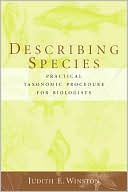Describing Species
Search in google:
A basic practical manual for the process of describing new species, this desperately needed desk reference and guide to nomenclatural procedure and taxonomic writing serves as a Strunk & White of species description, covering both botanical and zoological codes of nomenclature. CABI Bioscience Fascinating reading.
List of IllustrationsxiiiList of TablesxviiPrefacexixPart 1Introduction1Chapter 1.Introduction3Describing the Living World3Why Is Species Description Necessary?4How New Species Are Described8Scope and Organization of This Book12The Pleasures of Systematics14Sources15Chapter 2.Biological Nomenclature19Humans as Taxonomists19Biological Nomenclature21Folk Taxonomy23Binomial Nomenclature25Development of Codes of Nomenclature26The Current Codes of Nomenclature30Future of the Codes36Sources39Part 2Recognizing Species41Chapter 3.Species and Their Discovery43Species Concepts44Processes Affecting Speciation46Taxonomic Characters53Examples of Ways in Which Biologists Have Discovered New Species55Sources65Chapter 4.Establishing Identity: The Literature Search71Mistakes and Bad Examples71Establishing Identity73Where to Find the Taxonomic Literature75How to Read the Taxonomic Literature83Species Descriptions83Taxonomic Literature Searching on the Internet87Sources88Chapter 5.Establishing Identity: Using Museum Collections95Collections, Museums, and Herbaria96Locating Material97Borrowing Material102Type Material103Visiting Collections: What to Expect and how to Behave105Cooperation with Systematists106Sources107Part 3Writing Species Descriptions113Chapter 6.Species Descriptions in Taxonomy115Reasons for Writing Species Descriptions115Different Kinds of Taxonomic Publications116Form of the Descriptive Paper125Chapter 7.Headings and Synonymies129Description Headings129Synonyms134Synonymies135New Species136Types of Synonymies137Terms Used in Synonymies140Different Kinds of Synonymies140References in Headings and Synonymies144Chapter 8.Naming Species: Etymology147Naming Species147Brief Review of Latin and Greek149Basic Rules of Species Names153Descriptive Species Names156Geographic Species Names164Commemorative Species Names165Nonsense Species Names169The Etymology Section169Sources171Chapter 9.Type and Voucher Material173Rationale for Types and Vouchers173Rules of Nomenclature Regarding Types175Selection of Types and Vouchers175Composition of Type Material177Documentation of Type Material178Deposition of Types179Type Section182Sources185Chapter 10.Diagnosis189What Is a Diagnosis?189Diagnosis in Zoological Taxonomy191Diagnosis in Botanical Taxonomy191What Is a Diagnostic Character?192The Diagnosis Section: Animals193The Diagnosis Section: Plants197Additional Uses for Diagnoses198Chapter 11.Description Section201Descriptive Writing201Information Used in the Description Section203Writing the Description210Telegraphic Style211The Description Section: Animals (Examples of Styles for Different Groups)214The Description Section: Plants (Examples of Styles for Different Groups)228Illustrating Taxonomic Descriptions231Sources238Chapter 12.Taxonomic Discussion Section241Purpose of the Discussion Section241Discussion in Descriptions of New Species242Evidence to Include247Composite Papers254The Discussion Section in Other Species Descriptions256Taxonomic Ethics257Chapter 13.The Ecology Section261Ecology in Species Descriptions261Analysis of Ecological Variation265Field Records: Getting the Most from Field Work265Ecological Information from Museum Specimens268The Ecology Section269Sources273Chapter 14.Occurrence and Distribution277Distributional Information in Species Descriptions277Parameters of Species Distributions278The Distribution Section281Distribution Papers289Sources290Chapter 15.Material Examined293Practical Value293In Original Descriptions294In Other Descriptions295Material Examined Section297Material Examined: Botanical Taxonomy300The Material Examined Paper301Sources302Chapter 16.Publication303Criteria of Publication: Zoology303Criteria of Publication: Botany306Preparation of the Manuscript307Submission of the Manuscript311Final Revision and Publication312Journals That Publish Taxonomic Papers314Part 5Beyond Species Description321Chapter 17.Subspecies323Why Are Subspecies Important?323Infraspecific Variation324Rules of Infraspecific Nomenclature: Zoology327Rules of Infraspecific Nomenclature: Botany329Deciding When to Name an Infraspecific Taxon330Writing Infraspecific Descriptions332Sources334Chapter 18.Genus-Level Description and Revision337The Genus Concept337When to Describe a New Genus341Generic Names341Publication of Generic Names346Generic Types346Examples of Generic-Level Description349Problems Caused by Generic Revision358Infrageneric Categories and Names360Sources363Chapter 19.Keys367Keys in Taxonomy367Key Characters370Single-Access (Analytical or Sequential) Keys371Multiaccess Keys (Polyclaves)375Interactive Identification378Key Construction378Computerized Key Construction379Sources380Chapter 20.Description of Higher Taxa383Family Concepts and Their Use in Taxonomy384Practical Significance in Biology385Describing Families386Family-Level Descriptions: Examples389Redescriptions of Family-Level Taxa394Descriptions of Taxa Above the Family Level396Problems with Nomenclature of Higher Taxa405Sources405Chapter 21.Common Problems407Missing Types407Lectotypes411Neotypes416Necessary Name Changes422Replacement Names: Homonymy424Conservation of a Name425Emendations427New Combinations428Lack of Information431Chapter 22.Further Studies in Systematics433Evolutionary Systematics434Phenetics438Cladistics439Molecular Systematics446Biogeography450Comparative Biology451Sources451Literature Cited455Subject Index489Author Index503Taxon Index513








